Akron Phy sics Club
Archive 2018
~~~~~~~~~~~~~~~~~~~~~~~~~~~~~~~~~~~~~~~~~~~~~~~~~~~~~~~~~~~~~~~~~~~~~~~~~~~~~~~~~~~~~~~~~~~~~~~~~~~~~~~~~~~~~~~~~~~~~~~~~~~
Newsletter
Meeting Announcement: MONDAY, January 29, 2018 - TANGIER, 6:00 PM
Dr. Bruce C. Taylor, Associate Professor Emeritus, Department of Biomedical Engineering, University of Akron
will be speaking on:
Techniques for Photographing Solar Eclipses
Our Speaker:
Bruce C. Taylor, PhD
Associate Professor Emeritus, Department of Biomedical Engineering, The University of Akron (2011 - present)
Associate Professor Biomedical Engineering, The University of Akron (1981 - 2011)
Associate Professor Electrical Engineering, The University of Akron (1990 - 2011)
B.S. Hiram College, 1964 (Biology)
MA Kent State University, 1966 (Physiology)
PhD Baylor College of Medicine/Kent State University 1971, Physiology/Biomedical Engineering
*
Director of Vascular Research, Akron City Hospital (1969 - 1978)
Director of Medical Engineering, Summa Health System (1978 - 1985)
Senior Research Fellow, NASA Ames Research Center (1995 - 2010)
Developed a Physiological Monitoring System for Space Sickness Avoidance
Minutes: January 29, 2018:
Club Charmain Bob Erdman started the meeting by thanking everyone for coming out on this lovely evening (no snow today).
We are delighted to see Theo and Max Newman, Dimitri Melnikov, Maxx Swoger and Fereshteh Memarian returning for tonight’s lecture.
Returning APC club member and past presenter Claire Tessier Ph.D. of the University of Akron Chemistry Department, was also there. Nice to see you again.
Program Chair Dan Galehouse then gave a rundown of the upcoming meeting presentations; February is Alper Dum, March is Marc Millis, April is Rouzbeh Amini, and June is Walter Lambrecht.
Dan encouraged us to contact him (This email address is being protected from spambots. You need JavaScript enabled to view it.) with presenters and ideas for the Sept 2018 – June 2019 APC meeting series.
Bob Erdman then asked everyone to use the new website registration process. He said that we need accurate timely numbers in order to confirm with Tangiers how many dinners will be needed.
Treasurer Rick Nemer reported that tonight we had 17 dinner guests, and three arrivals just for the lecture. Tangiers billed us for $306. We collected $290 for dinner. Our plastic Tupperware official bank vault started with a whopping balance of $210. And therefore closed with the hefty sum of $194.00 So right now we are well situated to handle upcoming sponsored student dinners.
Notes on the January presentation on Techniques for Photographing Solar Eclipses
by Bruce Taylor Ph.D., Associate Professor Emeritus, Department of Biomedical Engineering, The University of Akron.
Our chairman Bob Erdman then introduced our speaker. Bob mentioned that among all of various positions and accomplishments of Dr. Bruce Taylor over the years, he also worked with NASA on the physiologic effects of being in space.
Our Treasurer Rick Nemer has known Dr. Taylor for ½ a lifetime. Rick was working in biomedical engineering in 1985 when he first met Bruce.
Some of the positions that Bruce Taylor has held over the years are:
Director of Vascular Research, Akron City Hospital (1969 - 1978)
Director of Medical Engineering, Summa Health System (1978 - 1985)
Senior Research Fellow, NASA Ames Research Center (1995 - 2010)
Developed a Physiological Monitoring System for Space Sickness Avoidance
Bruce has been an avid photographer and stargazer for years, and that led him to today’s talk.
- - - - - - -
Bruce began by telling us that having traveled south to see the August 21, 2017 solar eclipse and taking lots of pictures, today he would like to speak about techniques for photographing the eclipse.
He stated, “All I can really give you is what I did, even though there must be over a 1,000 other methods available. I will talk about what I did and the other technologies that are available.”
Bruce mentioned that some of the equipment used is fairly expensive and if you’re only going to do eclipses with it - it’s not worth it. So you should do other things (i.e., general photography, pictures of the Moon & stars, etc.) to make the expenditure more worthwhile.
Seeing an eclipse involves getting into the Moon’s shadow.
Bruce explained that there are three parts to the shadow. The Umbra (total eclipse), Penumbra (partial eclipse) and the Antumbra (annular eclipse when the moon is smaller than the sun and you get an annulus around the moon).

Here is the path of totality for the August 2017 total solar eclipse. Situate yourself somewhere inside the path to see the entire outline of the Sun covered by the Moon.
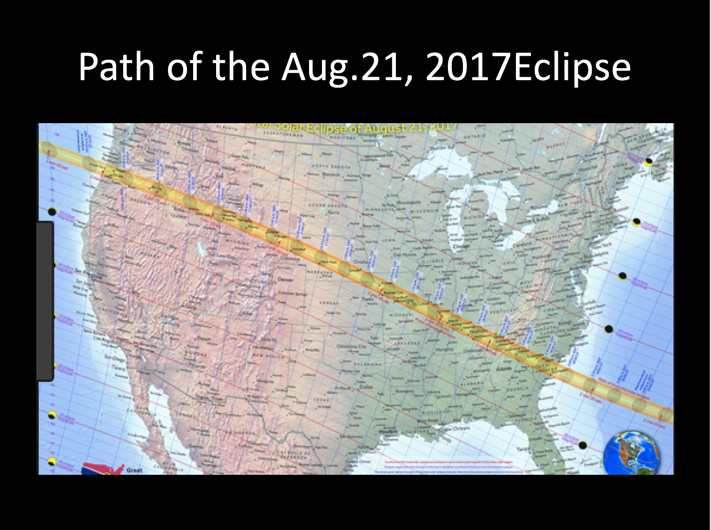
Bruce originally wanted to go to Montana or Wyoming to watch the eclipse, since he has a good friend living out there. But his friend told him that every room within 100-miles is gone and has been for 6-months.
(I can attest to that because hotel suites that were booked even as long as 1-year ago were canceled by the hotels for rebooking at a higher price, once they realized the eclipse was happening there and they were sitting on prime real estate!)
So instead Bruce decided to head south to North Carolina.
He ended up just a little south of Smokey National Park. At that location the length of eclipse totality (the maximum phase of a total eclipse during which the Moon's disk completely covers the Sun) was 2.5-minutes for him and his daughter to enjoy, who also went along on the trip.
Since 2.5 minutes is a short time-period it’s prudent to prepare your cameras ahead of the actual event. No time then to be fidgeting around.
Fortunately, Bruce had 2 cameras setup, because just as the total eclipse started, he accidentally kicked one of the camera’s tripod off target and had no time to line it up again.
Thankfully due to prior planning the other camera was set to automatic - so it clicked away just fine.
Why use an equatorial guided camera mount?
If you take a camera and aim it at the pole star Polaris and do a time exposure, your will see that all of the stars appear to rotate around in a circle. They rise in the east and set in the west, around the north star Polaris.
In order to minimize the diurnal drift in the camera you need to counteract that rotational motion.
Now get out your slide rule and do some calculation, and low and behold see the altitude that you aim the camera up is equal to the latitude where you are on the Earth.
His camera mount has a scaled wedge to adjust the camera angle to the latitude since I wanted a solid platform for taking pictures
It’s VERY IMPORTANT not to look at the Sun with your eyes, without proper protection. Do not use sunglasses or unexposed film (which does not block the UV radiation that burns your eyes).
Welders goggle (#14) is OK since it’s very dense. You can’t see thru it at all unless you are looking at the sun.
Or you can buy commercially available Mylar glasses.
Bruce explained, “I bought my glasses from Amazon, but they recalled them just 2-days before the eclipse because they could not verify where they came from.”
So don’t look at the eclipse without eye protection.
Bruce had a 600mm lens on a 25-megapixel camera which a fairly high resolution. With that you could easily see the sunspots on the sun.
He has a movie of the eclipse made up by combining frames from the camera.
The total eclipse was about 3-hours and something with the time of totality about 2.5 minutes.
So what happened at totality time?
When totality occurred the solar corona flashed a little bit. The camera was setup to take three pictures with every click of the camera (bracketed - lower reduced f-stop, one right on, and one above)
The noticeable Diamond Ring effect was visible at the beginning of totality. And a solar flare visible off on the right showing up, a coronal mass ejection (flare) from the surface of the sun
The solar corona, which is the sun’s atmosphere, extends out farther than the diameter of the sun.
One thing that kind of interesting is my daughter had her cell phone with her and decided to take some videos of the people who were watching the eclipse
We then watched that nice videos.
Bruce took 2,000 pictures during this eclipse.
On a total eclipse it’s hard to know what setting to use. That’s why bracketed shoots are good.
3 or 5 shots (bracketed setting) per clip
You need a solar filter to view the eclipse. Once into totality remove that filter and readjust the zoom and camera setting.
Nikon D700, has U1 and U2 feature on the Nikon lets you setup the settings ahead of time.
Nikon has batteries. Remember to bring fresh batteries.
The next total solar eclipse, on April 8, 2024, will be visible from Cleveland Ohio. But hopefully the notorious Cleveland April weather will give us a break and allow the eclipse to be seen.
That’s it. Thanks very much Everyone applauded and the floor was open to questions.
John Kirszenberg, Secretary
~~~~~~~~~~~~~~~~~~~~~~~~~~~~~~~~~~~~~~~~~~~~~~~~~~~~~~~~~~~~~~~~~~~~~~~~~~~~~~~~~~~~~~~~~~~~~~~~~~~~~~~~~~~~~~~~~~~~~~~~~~~
Newsletter
Meeting Announcement: MONDAY, February 26, 2018 - TANGIER, 6:00 pm
Dr. Alper Buldum, Professor, Department of Mechanical Engineering, The University of Akron
will be speaking on:
Lego Bricks at the Nanoscale:van der Waals Heterostructures
Abstract:
Assembling atomically thin two dimensional materials such as graphene with other materials using non-covalent interactions have attracted great interest in recent years. These mixed van der Waals heterostructures opened new venues in fundamental research of materials and also in new possible technological applications. In this talk, we will present recent research on these structures containing graphene and fullerenes. It will include experimental investigations and theoretical modeling efforts on their structures, physical properties and their possible electronic device and energy storage applications.
The Speaker:
Alper Buldum is a professor in the Department of Mechanical Engineering at The University of Akron. Dr. Buldum also has joint titles in the Department of Physics and Department of Chemistry. He received his BS, MS and PhD degrees from Bilkent University in Turkey. Dr. Buldum was a postdoctoral research associate and then research assistant professor at North Carolina Center for Nanoscale Materials at The University of North Carolina at Chapel Hill. He was also a visiting scientist at IBM Almaden Research Laboratories and Harvard University Department of Chemistry and Biochemistry. Prof. Buldum joined UA in 2001.
Minutes: February 26, 2018:
NOTES ON:
Lego Bricks at the Nanoscale: van der Waals Heterostructures
by Dr. Alper Buldum, Professor, Department of Mechanical Engineering, The University of Akron
Bob Erdman, our Club Chairman, then introduced our speaker Dr. Alper Buldum.
Alper Buldum’s research has its foundations in the early applications of quantum mechanics to electrons in crystalline solids. Using the powerful computer capabilities now available, Alper is describing feasible routes to advanced devices that utilize the intricate possibilities provided by the electrons in crystals, in graphene sheets and similar sheets of other combinations of atoms, and in three dimensional crystals of molecules, to inspire the construction of many kinds of new electronic devices.
He envisions the utilization of the dipolar forces between sheets of atoms and crystalline arrays of atoms and molecules to create many kinds of modules that can be assembled together to perform functions such as energy collection, data storage, mechanical actuation, feedback control of manufacturing processes, and many more.
Professor Buldum’s calculations describe the regions within a tiny crystal, in which the electrons with a particular energy are likely to be found. He calculates the location and shape of quantum mechanical states. of available to an electron in a particular “state”. He calculates the probability of finding an electron in particular regions of three dimensional space, with a particular kinetic energy. These fundamental concepts are used to design contemporary devices. Similar calculation are important in biology, particularly in the nervous system, when combined with the knowledge of movements of atoms and molecular segments that are essential in biology. The molecular conformations of the atoms of a protein molecule (a kind of biopolymer that contains many atoms) can now be modeled and followed as the proteins performs their essential biological functions. Professor Buldum, with his students and colleagues contribute to this massive contemporary effort.
Alper provided many examples of applications that combine knowledge of functional electrons and molecules and biological phenomena and the photons that bring light and power from the sun to earth. 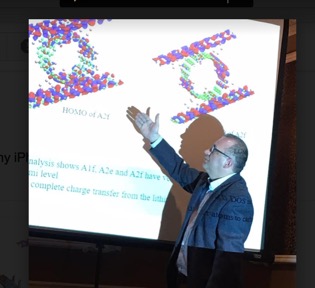
This image shows Professor Alper Buldum describing the results of his calculations of some electronic states of electrons in molecules between graphene sheets.
Darrell Reneker, Vice Chair
~~~~~~~~~~~~~~~~~~~~~~~~~~~~~~~~~~~~~~~~~~~~~~~~~~~~~~~~~~~~~~~~~~~~~~~~~~~~~~~~~~~~~~~~~~~~~~~~~~~~~~~~~~~~~~~~~~~~~~~~~~~
Newsletter
Meeting Announcement: MONDAY, March 26, 2018 - TANGIER, 6:00
Marc Millis, Propulsion Physicist & Founder of the Tau Zero Foundation
will be speaking on:
Interstellar Flight and Propulsion Physics
Abstract:
The challenges of interstellar flight are introduced, along with spacecraft concepts which are based on known physics. Concepts that consider undiscovered physics are also presented, with an emphasis on the steps needed to see if, and how, such ambitions might someday be achieved.
The Speaker:
Marc Millis is best known for leading NASA's Breakthrough Propulsion Physics project (1996-2002) and the 2009 book, Frontiers of Propulsion Science – examining the physics of non-propellant space drives and faster-than-light flight. In 2010 Millis took an early retirement to continue these edgy pursuits via the nonprofit Tau Zero Foundation.
Minutes, March 26, 2018
NOTES ON:
Interstellar Flight and Propulsion Physics
by Marc Millis, Propulsion Physicist & Founder of the Tau Zero Foundation
Bob Erdman, our Club Chairman, then introduced our speaker Marc Millis.
The fascination over interstellar travel is a major constituent of science fiction. It has the aura of eternity mixed with the imperative of the fountain of youth. Marc Millis has taken us on a scientific journey, a discussion that is, of the engineering challenge of traveling to the stars. -- It is his vocation and avocation. The scale of 'outer space' is beyond comprehension. Exploration, even at light speed, appears to exceed human resources.
Some hope is offered by new discoveries of planets orbiting the closer stars. Observations include sizes, temperatures and stellar radiation levels. More information on composition and chemistry is anticipated. A number of potentially habitable planets are extant within fifty light years of earth.
Accessibility is severely hampered by the limitation of light speed and the enormous scale of the universe as compared to the time scales of human endeavors. 
For current spacecraft, the edge of the solar system may be accessed in a century but habitable planets will require a significant fraction of light speed to be accessible within a reasonable time. Getting there is the problem.
Current space technology is only a precursor to real interstellar travel. A serious attempt will require new infrastructure incorporating construction in space. A real method to do this, as inspired by the science fiction of today remains undiscovered.
An improved unmanned interstellar explorer is under discussion. A breakthrough technology, such as laser powered solar sails has been conceptualized but remains elusive to engineering. An earlier study (Daedalus) involves space construction and developments beyond present capabilities. Ignoring details of technological development, it can be shown that even the projected energy requirements are impractical.
New technology is required and must be fed by a breakthrough in fundamental science. And further advances of technology may make an attempt obsolete even before it could play out. Because rocket propellant must be propelled as part of the rocket itself the total requirement becomes enormous for long distances. Some calculations give a propellant mass comparable to the mass of the sun.
A true revolution in science is required. Innovations at current technology levels are insufficient. The engineering requirements need new physics. 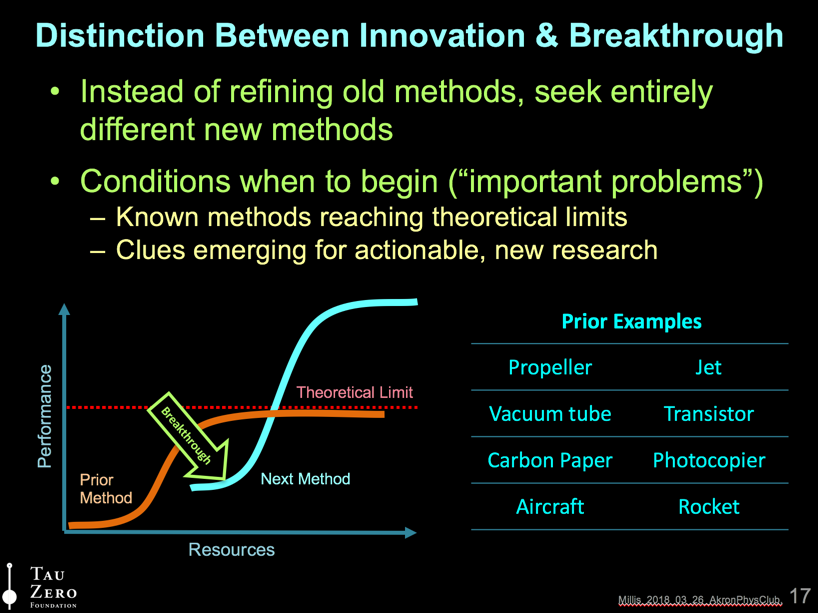
These difficulties led to the 'Breakthrough Propulsion Physics Project' (1995-2002), (2003-2007), a systematic attempt to sort through current knowledge looking for possibilities. This resulted in the book, “Frontiers of Propulsion Science.”
The 'warp drive', born of science fiction, supposes that the fabric of space time can be distorted to allow local objects to move faster than the outside universe.
(See Alcubierre, M. (1994), 'The warp drive: hyper-fast travel within general relativity,' in Classical and Quantum Gravity, Vol. 11, pp. L73-L77).
Another related approach is the classical wormhole, studied by Weyl, Einstein and Rosen, and Morris and Thorn, that supposes an internal space-time link between different regions that can be used as a 'shortcut' or bridge from one place to another.
Otherwise, there may be a way to create faster than light motion using negative mass. And perhaps space can provide forces that can push a spacecraft in the sea of space, like the surface tension of a soap film can push a boat on water. These sorts of techniques would reduce propellant requirements. But practical and theoretical problems remain.
A Mach effect thruster has been proposed. Modification of mass density by insertions of energy are purported to react differently to external forces in such a way as to give a net result. A drive developed by J. F. Woodward is off this type and is being tested in at least three different labs. The fiducial thrust is 3 micro-newtons at 30 watts.
A more general class of possibilities depends on various conceptualizations of inertia. Different paradigms for inertia exist and these have not been resolved by quantum mechanics. Many possibilities appear to be open.
(An elementary discussion is in: Mach’s Principle: From Newton’s Bucket to Quantum Gravity, by Barbour and Pfister, Birkhauser, (1995). Also see: Tajmar (2017) Mach-Effect thruster model, Acta Astro V.141, pp 8-16 for experimental studies).
A number of candidate methodologies have been proposed and are being systematically evaluated.
Negative mass propulsion remains as a candidate since the early discussion by Bondi. Other oddities, whether controversial, poorly explained, or misunderstood may be inferred to lead to new methodologies. This includes the color dependent variation of light velocity in matter, the discrepancy of astronomical distance measurements, observations of anomalous galactic rotation, the correlations between masses of astronomical bodies and their angular momentum, and the mystery of double valued rotations.
A non-profit organization, the 'Tau Zero foundation' has been set up to support these activities.
General information is available on-line at:
https://www.centauri-dreams.org/
https://tauzero.aero/,
and, http://www.tu-dresden.de/ilr/rfs/bpp
We then thanked Marc Millis for this eye opening and inspiring presentation. The floor was then opened for questions.
Dan Galehouse, Program Chair
~~~~~~~~~~~~~~~~~~~~~~~~~~~~~~~~~~~~~~~~~~~~~~~~~~~~~~~~~~~~~~~~~~~~~~~~~~~~~~~~~~~~~~~~~~~~~~~~~~~~~~~~~~~~~~~~~~~~~~~~~~~
Newsletter
Meeting Announcement: MONDAY, April 23, 2018 - TANGIER, 6:00 pm
Dr. Rouzbeh Amini, Assistant Professor of Biomedical Engineering, The University of Akron
will be speaking on:
Using Engineering Tools to Study Heart Valves
Abstract:
In the tricuspid valve, located between the right ventricle and the right atrium in the heart, the leaflets open and close more than three billion times during their lifetime. We are particularly interested in understanding why tricuspid valve surgeries have poor long-term success rates (more than 30% of patients who undergo surgery have had a recurrence of valve problems). We aim to understand how tricuspid valve repair procedures will affect the valve’s function, as we believe that surgical alterations cause changes in tissue mechanical stress and tissue microstructure in ways that can eventually lead to failure of the repaired valve.
The Speaker:
Dr. Amini completed a Ph.D. in Biomedical Engineering at the University of Minnesota in the field of ocular biomechanics and biotransport in 2010. He then continued his research work on the mechanics of soft tissue as a postdoctoral trainee at the University of Pittsburgh’s Department of Bioengineering, where he held the Ruth L. Kirschstein National Research Service Award (NIH F32). Dr. Amini has served as an assistant professor in the Department of Biomedical Engineering at The University of Akron since August 2013. Dr. Amini’s research has been funded by the National Science Foundation, Akron Children’s Hospital, Firestone Foundation, American Heart Association, and the BrightFocus Foundation.
Minutes, April 23, 2018:
Using Engineering Tools to Study Heart Valves
RouZbeh Amini, PhD,
Assistant Professor of Biomedical Engineering
The University of Akron
The human heart is comprised of four chambers, The Right Atrium, Right Ventricle, Left Atrium and Left Ventricle. At the outlet of each chamber is a valve whose purpose is to keep the blood flowing in the proper direction. These valves are named, The Tricuspid Valve, Pulmonic Valve, Bicuspid Valve and Aortic Valve. These valves must open and close each time the heart beats, 104,680 beats per day. Any problem with any of the valves can cause serious problems and even death.
Two types of problems that can occur are failure of the valve to close completely, which permits the blood to reverse its flow (regurgitation) and failure of the valve to open completely (stenosis), thereby restricting the flow of blood. One of the surgical procedures to correct regurgitation problems with the Tricuspid Valve is called Tricuspid Annuloplasty and involves implanting a ring around the valve to force it to close when it is supposed to close. While this surgical technique works in the short-term, its long-term success is minimal.
Dr. Amini’s research, at The University of Akron, involves studying the tissue properties of the Tricuspid Valve to determine why the long-term success of Tricuspid Valve Annuloplasty is not as one would hope. Approximately 30% to 40% of surgical repairs have had a recurrence of the valve problem. The research involves a study of the valve’s function at the tissue level and at the cellular (micro) level. The research has found that that the surgical alterations cause changes in the tissue stress and the tissue microstructure in ways that can eventually lead to failure of the repaired valve. The studies have shown that the cellular structure of valvular tissue causes the tissue to be anisotropic (the tissue stretches differently depending on direction) and this is what leads to failure of the surgically-repaired valve. Knowing this, Dr. Amini’s research should permit the design of a prosthetic device that would take into account the anisotropic nature of the valve tissue resulting in better long-term results.
Review submitted by,
Bruce C. Taylor, PhD
Associate Professor of Biomedical Engineering, Retired
The University of Akron
~~~~~~~~~~~~~~~~~~~~~~~~~~~~~~~~~~~~~~~~~~~~~~~~~~~~~~~~~~~~~~~~~~~~~~~~~~~~~~~~~~~~~~~~~~~~~~~~~~~~~~~~~~~~~~~~~~~~~~~~~~~
Newsletter
MEETING ANNOUNCEMENT: June 4, 2018
The Tangier Restaurant
532 West Market Street, Akron Ohio
6:00pm Socializing - 6:30pm Dinner - Program about 7:30pm
The charge for each dinner is $20
RESERVATIONS or REGRETS by Thursdday, May 31st:
To register for this event please click on Menu item "Meeting Registration"
above, and fill out the form
Please use this email (Secretary Carol Gould: This email address is being protected from spambots. You need JavaScript enabled to view it.)
for updates on email addresses or to discontinue receiving these announcements
VISITORS ARE WELCOME - COLLEGE STUDENTS, please indicate this on your reservation. Dinner is $10
[College students having dinner: Please identify yourself as a student]
Anyone is welcome to attend the free presentation starting at 7:30 pm.
But if you would like to have dinner, you will need a reservation.
- - - - - - - - - - - - - - - - - - - - - - - - - - - - - - - - - - - - - - - - - - - - - - - - - - - - - - - - - - - - - - - -
Tour the City of Akron Underground Tunnel Project
- - - - - - - - - - - - - - - - - - - - - - - - - - - - - - - - - - - - - - - - - - - - - - - - - - - - - - - - - - - - - - - - -
No speakers will be present at our
Tangier Dinner 6:00 pm meeting.
The speakers listed below will ONLY be THERE for the tour portion. At dinner we will meet to discuss what we saw on the tour.
Our Tour Guides will be:
Heather Bolestridge - Communications Manager for the Waterways Renew Project
Mike Wytrzyszczewsk - Engineering Projects Coordinator
Please come and join us, June 4th at 4:00 pm
Tour the City of Akron Underground Tunnel Project
Meet at the Cascade Locks Park Association - Mustil Store location at 89 W. North Street, Akron Ohio 44304.
Parking is nearby.
Our Tour Leaders:
Heather Bolestridge is the Communications Manager for the Akron Waterways Renewed! Program. Her professional career began during a five-year enlistment in the U.S. Navy, where she served as a Mass Communications Specialist. After being honorably discharged, she moved to Texas with her husband J.T., and earned a Bachelor’s of Arts in Applied Communication from Kent State University. She moved from Texas to Akron to work on the AWR! program, as well as to return to her roots in Northeast Ohio.
Heather and J.T. have two sons; Jude 4 and Jarc 2. Heather enjoys paddle boarding, fitness, hiking, sports, music, travelling, volunteering, and spending time with her family. Her future goals include earning a master’s degree and completing a backpacking trip on every continent (except maybe Antarctica!)
Mike Wytrzyszczewsk is an Engineering Projects Coordinator with the Engineering Bureau for the City of Akron.
For the past 25 years he has overseen the construction of numerous capital improvements for the City. Mike is the Construction Project Manager for the Ohio Canal Interceptor Tunnel. OCIT has been in under construction since November 2015 with an anticipated end date of July 2019. The highlight of the project is a 30’ diameter (27’ finished) tunnel boring machine (TBM) named “Rosie” which was launched in October of 2017 and is currently mining under the roads of Akron.
*
On the Menu bar above, select "Meeting Registration," then fill out the registration form. Register SEPARATELY for each event that you want to attend (the Tour and/or the Tangier dinner afterward).
Minutes, June 4, 2018:
About 50 of us enjoyed the educational tour.
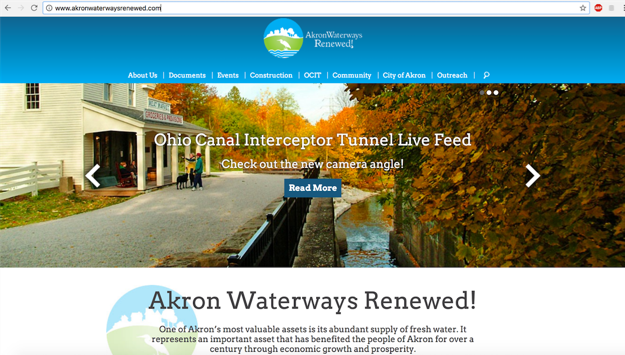
http://www.akronwaterwaysrenewed.com/
-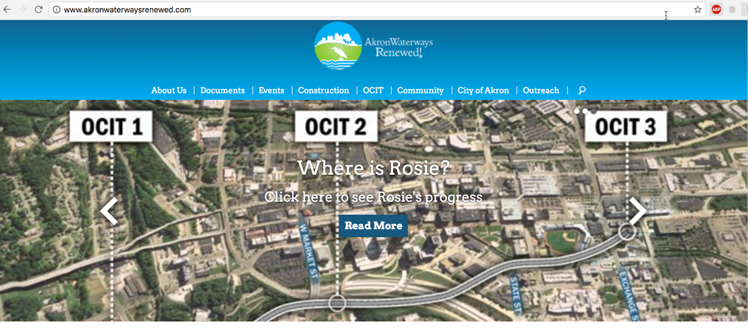
-
Ohio Canal Interceptor Tunnel (OCIT) - video explains the entire project. Also at that URL is a link to the (OCIT-1 Live Webcam)
http://www.akronwaterwaysrenewed.com/ocit.aspx
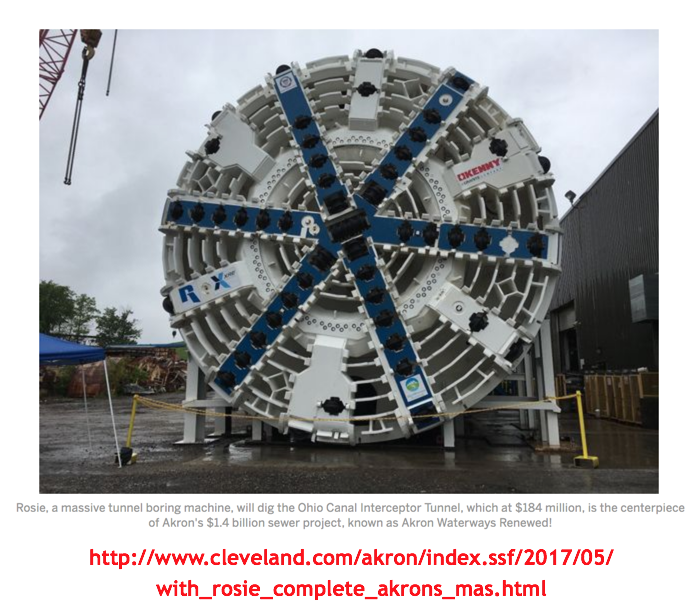
We thanked Heather Bolestridge, Mike Wytrzyszczewsk and the others who gave us a wonder tour and answered many questions.
Then at the Tangier Restaurant 23 of us had great food and enjoyed a question & answer session with Greg Loesch of the Akron Water Department. His area of expertise is providing the residents of Akron with fresh daily water.
John Kirszenberg, Secretary
~~~~~~~~~~~~~~~~~~~~~~~~~~~~~~~~~~~~~~~~~~~~~~~~~~~~~~~~~~~~~~~~~~~~~~~~~~~~~~~~~~~~~~~~~~~~~~~~~~~~~~~~~~~~~~~~~~~~~~~~~~~
Newsletter
Meeting Announcement: MONDAY, September 24, 2018 - TANGIER, 6:00 pm
Dr. Ben Schumacher, Professor of Physics, Kenyon College
will be speaking on:
The Private Lives of Quantum Particles
Abstract:
Quantum physics is full of famously weird phenomena, from the two-slit experiment to the power of quantum computing. But it turns out that many of these phenomena can only be observed under conditions of the strictest privacy, in which the systems are "informationally isolated" from the rest of the world. As we will see, this is no accidental feature of quantum theory, but rather points to a profound principle of nature: Quantum physics is what happens when nobody is looking.
Bio:
Benjamin Schumacher is Professor of Physics at Kenyon College, where he has taught for 30 years. A student of the late John A. Wheeler, he received his Ph.D. in Theoretical Physics from the University of Texas at Austin in 1990. He is the author of numerous papers and textbooks on special relativity and quantum mechanics. As one of the founders of quantum information theory, he introduced the term "qubit", invented quantum data compression (also known as Schumacher compression), and established several fundamental results about the information capacity of quantum systems. For his contributions, he won the 2002 Quantum Communication Award, the premier international prize in the field, and was named a Fellow of the American Physical Society. Besides working on quantum information theory, he has done physics research on black holes, thermodynamics, and statistical mechanics. Professor Schumacher has been a visiting scientist at Los Alamos National Laboratory, a Moore Distinguished Scholar at the Institute for Quantum Information at California Institute of Technology, A Rosenbaum Fellow at the Isaac Newton Institute of Cambridge University, and (most recently) a Meaker Visiting Professor at the Institute for Advanced Studies of the University of Bristol.
Minutes: September 24, 2018:
Club Chairman Bob Erdman called the meeting to order and welcomed everyone to the first meeting of the new school year.
We then had the pleasure of hearing a brief history from everyone at the meeting, about how they heard about the Akron Physics Club and decided to attend meetings. As we went around the room, table to table, it was great to hear what sparked peoples interest and for how many years they have been coming to the Club. More than a handful of people have been attending for 15+ years.
Bob and Treasurer Rick Nemer informed us that the Tangier will be raising the cost of our meals by $2 starting in January. That means we must also increase our charge for dinner to $22 per person. Student dinners will stay $10 since that is still subsidized by Club member contributions.
Secretary John Kirszenberg informed us that a plaque for former Club member and Secretary Jack Gieck was unveiled at the Cascade Locks Park Association gardens for his contributions (research and books) to documenting the history of Akron’s Industry and canal system.
More info on this at - http://akronphysicsclub.org/index.php/advanced-stuff
Program Chair Dan Galehouse then confirmed that next month there would be a tour at Anderson Laser, followed by a presentation by David Windisch on “Rocketry & Telescopes” at the Tangier. He is still trying to reach Dr. Walter Lambrecht for a November presentation. Other dates are being lined up for future meetings.
Notes on:
The Private Lives of Quantum Particles
by Dr. Ben Schumacher, Professor of Physics, Kenyon College
Dan Galehouse our Club Program Chair, then introduced our speaker Ben Schumacher.
Dr. Schumacher was a student of the late renowned physicist, John Wheeler. Ben is currently a Professor of Physics at Kenyon College, where he has taught for 30 years. He is a Los Alamos National Laboratory visiting scientist, and distinguished Fellow of the American Physical Society, having earned various awards for his contribution to the field of quantum physics.
We gave Dr. Schumacher a round of hearty applause and thanked him for making the long car trip to be here with us tonight.
Dr. Schumacher then began with…
Quantum computing is a big part of the field I am in, which is so called quantum information science. But the thing that really interests me, thinking about processing and quantum physics, is what it really reveals to us about the world.
So although we’ll have a slide about quantum computing along the way, which I hope will be of some use, I’m mostly going to talk about things that are simpler than quantum computers. But are necessary for the magic that quantum computers might be able to do.
My title is the private lives of quantum particles and I want to start with a quotation from another student of John Wheelers, Richard Feynman who said, “nobody understands quantum theory.”
Let’s review the basic ideas on how the world works. We’ll discuss the strange nature of quantum physics, and things like quantum interference and quantum entanglement. And also about relationships. That is to say, about relationships between particles. It’s a relationship that can never be fully disclosed to the outside world.
Face it. We live in a world of shy particles.
Of interest is super-position, entanglement, and effects on wave interference.
Remember Young’s two slip experiment? The two slit experiment shows us almost everything about quantum mechanics in it.
A single slit diffraction pattern is just a smear of light. Two slits open – produce an interference pattern, an arrangement of light and dark bands. And the reason is that the light waves, emerging from the two slits, at some place on the screen the waves add up, they arrive in sync, and in some places they arrive out of sync, so they cancel each other out.
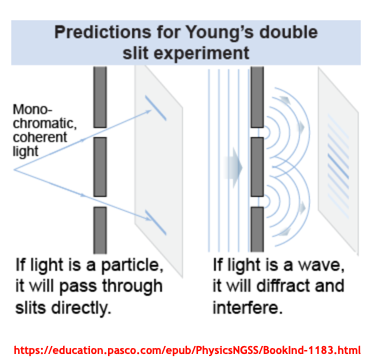
Light propagates thru space as a wave but also as a particle. It carries energy in the form of photons.
So what does this experiment look like in photon language?
Turn the light intensity way down. Send 16 photons thru at one time and they sort of just land in places. The more photons you begin to see a pattern. Because of probability, at some places they are not likely to land while at other places they are more likely to land.

Sent thru a trillion photon and you get the nice smooth distribution. So the wave intensity is really telling us that the probability that a particle like a photon will land there.
Wave intensity is proportional to particle probability.
What we have talked about demonstrates quantum super-position. In the quantum state, a particle can be two things at the same time (i.e., different spins).
A quantum state provides a probability distribution for the value of each observable, i.e. for the outcome of each possible measurement on the system.
In quantum mechanics and particle physics, spin is an intrinsic form of angular momentum carried by elementary particles, composite particles (hadrons), and atomic nuclei.
The quantum world of super-position:
Example using a penny = a penny is either heads or tails. But while it spins, is it a head or tail? It's not really one or the other. It is a combination of both at the same time.
So we can either do an “interference” experiment or we can do a “which slit” experiment, but not both on the same photon. And importantly, we cannot say what would have happened if we had made another choice.
But surely a particle can only go thru one slit?
Let’s imagine this next experiment. Introduce a device that doesn’t absorb photons but can tell which slit the photon went thru, whether the right or left one will register. Maybe a single atom that can get its state slightly changed if a photon flies by?
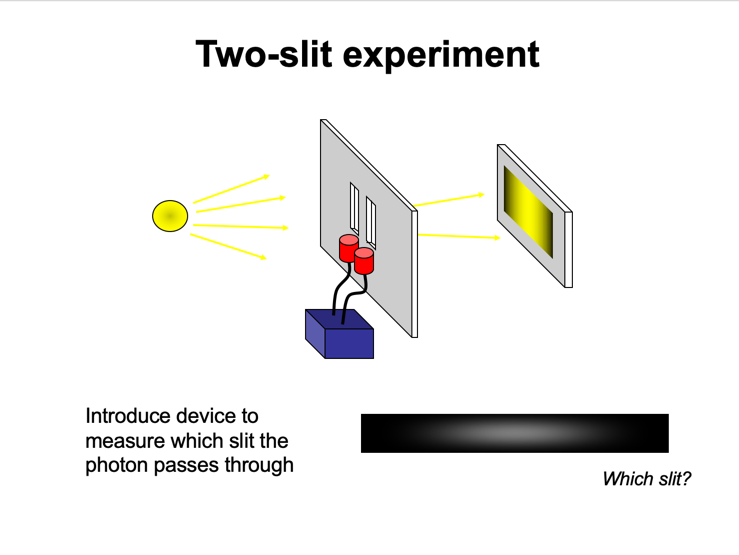
What happens is the interference effect goes away! When you do the experiment to measure which slit the photon goes thru, then it’s as if you don’t get the wave phenomenon, or interference effect.
Quantum interference of photons can only occur if NO MEASUREMENT is made of “which slit” the photon passes through.
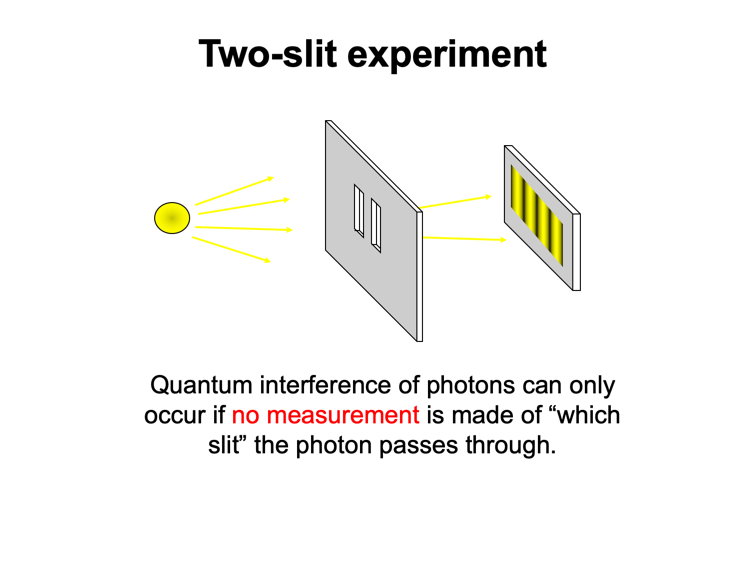
So we can either do an interference experiment by not measuring it or we can do a which slit experiment – but we can’t do both on the same photon. Mutually exclusive. You have to choose.
So that is all related to how quantum computers work. They work like the two slit experiment.
Quantum computing creates new possibilities and new ways to approach problems that classical computers have difficulty doing. There are also certain kinds of problems where classical computers run out of space. Even with the world’s biggest super computer this can happen. A quantum computer gets around that.
We make quantum chips really really cold. We cool our quantum chips down cold enough that we can create super-positions and we can entangle qubits, and the information isn’t lost to the environment. Room temperature is 300-Kelvin, but we go down to 10 milli-Kelvin. For the quantum computer, rather than using transistors we use spins.
We use micro-wave pulses to control the state of each qubit. We’ve calibrated these micro-wave pulses so that we know exactly, this kind of pulse, with this kind of frequency, and this duration will put the qubit into super-position, or will flip the state of the cubit from zero to one.
What happens is that the computer is setup, and instead of just having it compute, let’s say a function, then you setup the input for that function in the computer’s memory. Since your computer is a quantum mechanical system you can prepare it in a quantum super-position of inputs, just like the particles (you can arrange for a photon to pass thru a super-position of a couple of slits).
So then you compute the function.
Now how many times are you computing the function? Once! You are computing it once on a super-position of inputs. It is computing it on a memory register, that’s in one of these quantum super-positions.
And then at the end, you do an interference experiment from all the results of these things, just like you can do an interference experiment from the various slits.
But it’s very important that you don’t ever find out exactly which value is computed. That’s the crucial thing. If you intervene in the computer to see what the input was here, the thing wouldn’t work. You wouldn’t be able to observe the interference effect. And what can you get out the interference effect? You can get out global properties and functions.
With a quantum computer you can sometime determine global properties of the function, like the period of the function, from the interference of the outputs. And that’s what gives quantum computers, presumably, their power.
Now we talk about that eerie feeling.
If we send one photon at a time into an interferometer (one input beam, mirror beam splitting, and two photon sensors), where does the photon end up? The photon can reach either detector. The photon “flips a coin” at each mirror. It’s probabilities!

Moral: if we observe which beam the photon travels, there is no interference.
Why should observing the photon destroy the quantum interference effects? A photon detector must interact with the photon, i.e., the photon must be able to make a physical change in the detector. Detector therefore makes a physical change in the photon; an information action & reaction principle. Observed photons act differently – they have that eerie feeling of being watched.
Next let’s discuss quantum entanglement.
Theory: We can assign a quantum state |Yñ to the pair, but not to individual particles.
Experiment: Behavior of the two particles is strongly correlated.
Spin is an internal angular momentum of a particle (e.g., an electron). We can measure the spin along any axis we choose. The result is always either +1 or -1 (in units of h/2). Entangled state of spins: total spin zero (TSZ), sometimes called a “singlet state” of two spins.
The quantum world of particle entanglement:
Two particles connected in a quantum way, that can be separated by distance if we want, but they retain their connection.
Example using TWO pennies = spin both pennies at different locations.
Stop one penny. If it is a head, stop the other penny and it will also be a head.
Spin both pennies at different locations, Stop one penny. If it is a tail, stop the other penny and it will also be a tail.
Both particles know and retain the information that they are entangled.
Both exactly correlated. It’s as if when the particles were formed, they both make an agreement about how to act.
So in conclusion, quantum physics happens when no one is looking.
Nobody understands quantum theory. The essential “quantumness” of nature (interference effects, entanglement) can only emerge when a system acts in private. Everyday macroscopic systems are very hard to isolate perfectly. We cannot put ourselves in the place of the quantum system in order to understand how it behaves.
We then gave Dr. Ben Schumacher a resounding stand of applause, and he entertained questions from the audience.
John Kirszenberg, Secretary
~~~~~~~~~~~~~~~~~~~~~~~~~~~~~~~~~~~~~~~~~~~~~~~~~~~~~~~~~~~~~~~~~~~~~~~~~~~~~~~~~~~~~~~~~~~~~~~~~~~~~~~~~~~~~~~~~~~~~~~~~~~
Newsletter
Meeting Announcement: MONDAY, October 22, 2018 - TANGIER, 6:00 pm
David Windisch, Optical System Engineer
will be speaking on:
Rocketry and Telescope
- - - - - - - - - - - - - - - - - - - - - - - - - - - - - - - - - - - - - - - - - - - - - - - - - - - - - - - - - - - - - - - -
Two separate events:
Anderson Laser Tour start at 4:00pm
Laser and Historical Equipment on Display
New address:
1508 State Road, Hinckley, OH 44233
and
Dave Windisch, Optical Systems Engineer
will be at Tangier (6:00pm) to speak on
Rocketry and Telescopes
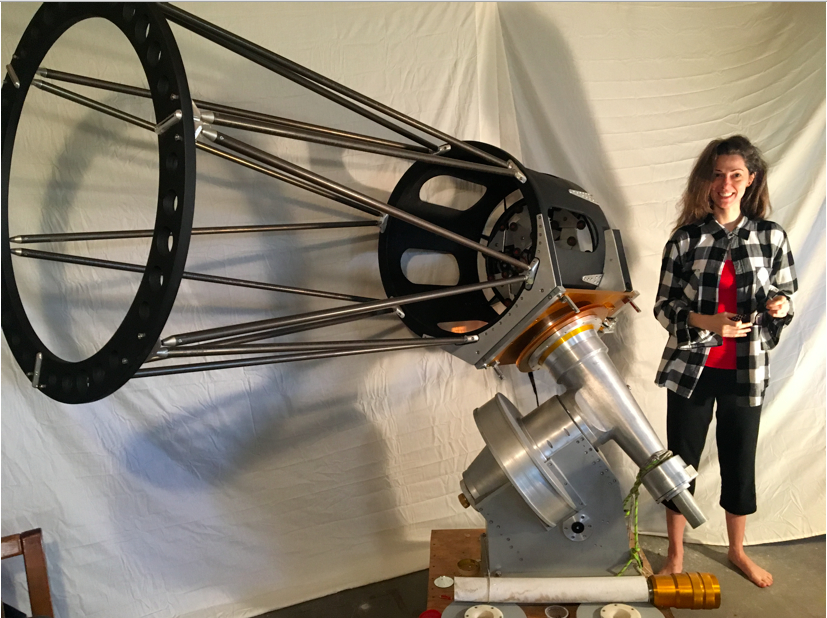
Abstract:
My project involves the building of 12 telescopes in the 0.75-1.0
meter class designed to hunt and track undiscovered and known
asteroids.
These scopes will be located strategically around the world so that at any one time, 3 or more can work together to track movement and process data on a particular object of interest. Orbit and trajectory will then be determined and subsequent threat assessments estimated.
Asteroids can and have ended life on this planet more than once. There are thousands that have yet to be discovered and tracked. Interestingly, asteroids are rich with minerals and fuel for interplanetary travel which will also become necessary for human race survival.
Bio:
Dave is an optical systems designer and has worked in the R&D laser
optics community for 40 years. He has a passion for telescopes and
likes to build them. The photo shows a 0.6-meter prototype that he built.
The remaining scopes to be built as described in his talk will look similar but be larger and therefore able to see much fainter objects.
Minutes: October 22, 2018:
Club Chairman Bob Erdman then introduced our speaker, Mr. David Windisch, We thanked David for coming today and gave him a round of applause.
David wanted this meeting to introduce us to the topic of what type of celestial objects exist in our solar system - that can and have impacted the Earth over the past centuries. What are they, where do they originate from, how often do they fall to Earth, and what possible implication does this have for the survival of our human species.
Folklore is filled with stories about shooting stars and we sometimes see them ourselves. Looking up at the heavens we may see a sudden streak of light, fireball passing overhead; and we call it a shooting star. However, we have since learned that these objects are not stars. They are small bodies of rock entering the Earth’s atmosphere, burning due to friction, and briefly lighting up the night sky.
While in space we call them meteoroids. As a shooting star we call them a meteor or bolide (an extremely bright meteor, especially one that explodes in the atmosphere), and if it per chance survives the fiery passage thru the atmosphere and lands on the ground, we call it a meteorite.
Many meteors and comets are left over from the dust that formed the Solar System and reside today in the Kuiper belt that exists beyond the orbit of Neptune. Some meteors are fragments of asteroids, broken off in collisions.
Huge meteor showers, caused by many meteoroids entering the atmosphere in one go, are caused by comets. We give them names like the Perseid meteor shower because they are seen coming from that constellation area in the sky. The Perseid meteor shower will burst into light in each August as Earth passes through the long trail left by Comet Swift-Tuttle.
How fast do they travel? Some have speeds of 6-42 miles per second. That equates to a speed of 300 times faster than a commercial jet plane. When they hit the ground they can create a crater 40 times larger than themselves. Imagine a few hundred tons of iron hitting the ground at 250 mph! The resulting craters are circular in shape, because a meteor impact creates a huge upward explosion.
There are three main types of meteorites:
iron meteorites: which are almost completely made of metal.
stony-iron meteorites: which have nearly equal amounts of metal and silicate crystals.
stony meteorites: which mostly have silicate minerals.
The metallic meteorites are composed of up to 80% iron and 20% a mixture of nickel, iridium, palladium, platinum, gold, magnesium and other precious metals such as osmium, ruthenium and rhodium.
Asteroids on the other hand, sometimes called minor planets, are small rocky bodies orbiting the sun. These range in size from nearly 583 miles across (Ceres) to dust particles.
Most asteroids reside in orbit between Mars and Jupiter. If their orbit becomes gravitationally unstable they may head toward the inner solar system (Sun, Mercury, Venus and Earth).
Asteroids are made up of metals and rocky material. Ceres appears to be composed of a rocky core covered by an icy mantle, where Vesta is thought to have a nickel-iron core, olivine mantle, and basaltic crust.
There are generally 4 classifications of asteroids:
Carbon C type – composed of 75% carbon
Silicate S type - Metallic iron mixed with iron-silicates and magnesium-silicates
Metallic M type - Iron/ nickel
Dark D type - Water ice/frozen carbon monoxide mixed with rock.
As satellites visit these solar system travelers were are learning more about them.
However, be on notice that a large asteroid hitting the Earth can be a life altering event.
It is currently hypothesized that the Chicxulub asteroid, which hit the Earth about 66-millions years ago, may have been responsible for the extinction of dinosaurs. It was 7 to 50 miles in diameter, landing in Mexico's Yucatan Peninsula. It struck with the same energy as 100 million atomic bombs, and left behind a crater 93 miles in diameter and up to 12.4 miles deep.
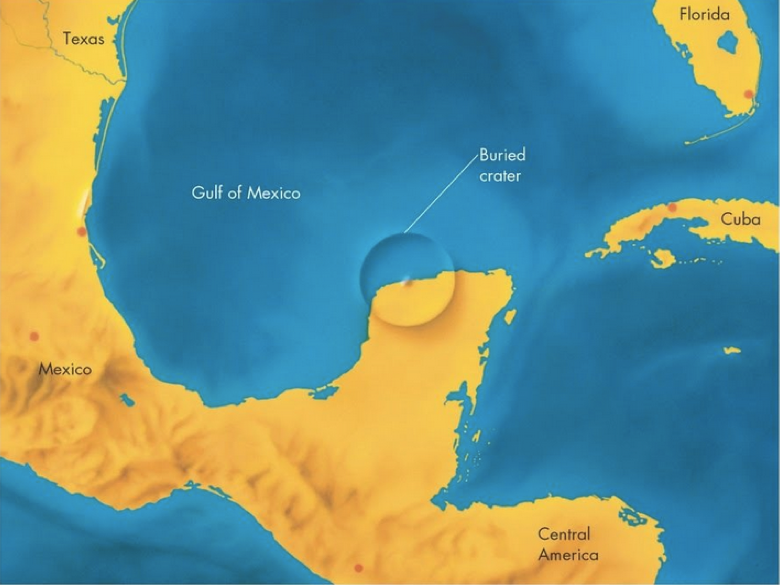
Other large asteroids have also hit the Earth. There are around 250 identified craters so far.
The Manicouagan Crater is one of the oldest known impact craters. It is in the Côte-Nord region of Québec, Canada.
It was caused by the impact of a 3 mile (5 km) diameter asteroid about 215.5 million years ago, during the Upper Triassic period.
The crater is a multiple-ring structure about 60 mi (100 km) across. Its inner ring is its most prominent feature. This is a 40 mile (70 km) diameter annular lake, the Manicouagan Reservoir, surrounding an inner island plateau. It is the earth's fifth largest confirmed impact crater.
Henbury Craters, a group of 13 meteorite craters in a desert area 8 mi (13 km) west-southwest of Henbury, Northern Territory, central Australia, within the Henbury Meteorite Conservation Park. The craters, recognized in 1931, crashed into the earth 4,700 years ago, lie in an area of 0.5 sq. mi (1.25 sq. km) and are distributed in a scattering ellipse typical of a cluster fall of meteorites. The largest crater (thought to be a coalescence of two smaller craters) is 733 ft. (217 m) long, 366 ft. wide, and 50 ft. deep. The others range from 30 to 266 ft. in diameter. The larger craters contain rock flour and fused silica glass.
The famous Barringer crater (Diablo Canyon, Arizona, USA) is 3,900 ft. wide, 590 ft. deep, and is the result of a 15 megaton explosion associate with the landing. It’s about 50,000 years old.
A 200,000 ton meteor upon hitting the surface, the resulting explosion and vaporization can eject as much as 400-millions tons of earth. It can briefly cause a 2,000 mph wind for up to 5 miles, and destroy vegetation within a 15 mile radius of the blast.
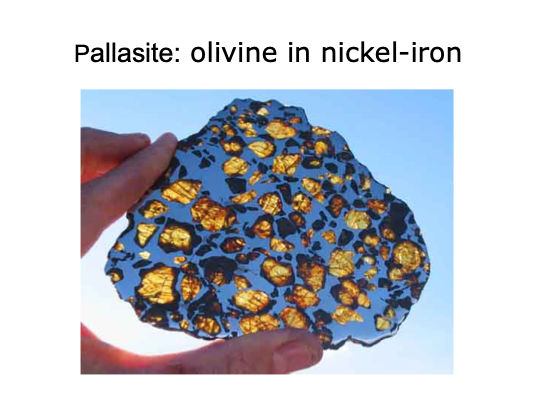
Turning our attention now to stars, we can say that they are formed from dense clouds of interstellar gas and dust, that collapse from gravity, resulting in compressed cores that ignite as hydrogen fuses into helium, lasting for millions or billions of years (re: the lifetime of a star depends upon the initial amount of mass that it has).
Today astronomers know a lot about stellar evolution. Once the hydrogen is exhausted the star burns helium, and then subsequently other heavier elements if present; carbon to oxygen to neon to silicon to sulfur and finally to iron which is stable. It may then collapse and eject material out into space.
Very massive stars live for only millions of years. Some explode as a nova or supernova (visible from millions of light years away) while others just peter out to become dwarfs.
Moderate sized stars like our sun can live for another 5 billion or more years. When our Sun becomes a red giant star, it will swell in size so big that its outer layers will consume Mercury and Venus, and reach Earth. The human race better has left by then.

To help identify possible asteroid threats to our planet, David Windisch and group has setup a number of telescope across the world to monitor the sky.
In David’s program there are 15 telescopes; two 24-inch, ten 30-inch and three 36-inch reflectors. They are in Oregon, California, Utah, New Mexico, Florida, Ohio and other places.
David has telescopes capable of seeing dim stars to magnitude 19, equatorial and polar aligned, with a CCD imager (to magnitude 22), astrometric reduction software, GPS receivers and to ability to resolve sky objects to .1 second of arc. We utilize adaptive optics (compensates for atmospheric twinkling) to get much better views.
Magnitude is a logarithmic scale, so a 7-magnitude star is 2.5 times fainter that a 6-magnitude star.
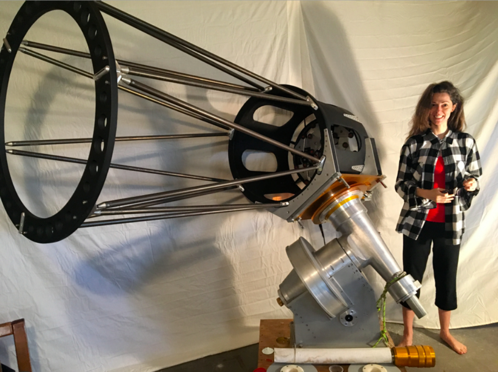
The International Astronomical Union Minor Planet Center
https://minorplanetcenter.net/
…is what David’s group uses and contributes information to. Their data base lists thousands of discovered/tracked minor planets. The daily page lists current minor planets approaching the Earth = https://minorplanetcenter.net/daily-minor-planet
The United States and Russia have current projects in development to mitigate, push or destroy Earth impact headed asteroids out of orbit.
David Windisch then thanked everyone for attending the talk.
We gave him a hearty round of applause, after which he entertained some questions.
John Kirszenberg, Secretary
~~~~~~~~~~~~~~~~~~~~~~~~~~~~~~~~~~~~~~~~~~~~~~~~~~~~~~~~~~~~~~~~~~~~~~~~~~~~~~~~~~~~~~~~~~~~~~~~~~~~~~~~~~~~~~~~~~~~~~~~~~~
Newsletter
Meeting Announcement: MONDAY, November 26, 2018 - TANGIER, 6:00 pm
Dr. Walter Lambrecht, Professor of Physics, Case Western Reserve University
will be speaking on:
Understanding the properties of halide perovskites using density functional theory
Abstract:
In this talk, I will use the halide perovskites as an example to illustrate the capabilities of modern density functional calculations. The halide perovskites form a new family of materials, which recently caused excitement for solar cell applications. They are easy to fabricate and have shown a remarkable increase in efficiency in a few years. Along with it came a great interest in understanding what gives these materials their superb properties for photovoltaics, such as strong light absorption, long recombination times and so on. Our own work has focused on their electronic band structures, exciton binding energies and stability with respect to competing crystal structures. Along the way, I will explain the methods that make these calculations possible, such as density functional perturbation theory for phonons and many-body theory extensions of density functional theory that provide accurate band gaps for semiconductors.
The Speaker:
Walter Lambrecht obtained his Dr. Sci. from Ghent University in Belgium in 1980. He is currently Professor of Physics in the physics department at Case Western Reserve University. He is a Fellow of the American Physical Society and was awarded the Faculty Distinguished Research Award by CWRU in 2018. His research interests are in computational and theoretical materials physics, focused on a variety of novel semiconducting and magnetic materials and the prediction of their properties from first-principles calculations. He is author of over 250 publications.
Minutes: October 22, 2018:
Summary of: “Understanding the properties of halide perovskites using density functional theory”
The perovskites are complex crystalline materials, having advanced structures, that are under development for use in solar cells. In a competitive field, solar cell effeciencies are rising rapidly towards the theoretical limit. The halide perovskites are approaching the capabilities of silicon.
These materials have a cubic structure A-B-X3 with an ‘A’ group or atom on the corner, an ‘X’ group or atom on the face and a ‘B’ group or atom in the center. Examples are CaTiO3, CsSnI3, or (CH3NH3)PbI3. It is an ionic crystal but but may include metal or organic moieties for flexibility. Halogen substitutions are used to adjust atomic sizes. Properties are tunable to allow for the efficient collection of incoming solar energy. Key questions are how to produce strong absorption, long diffusion paths for carriers, low recombination rates, increased conductivity and long term stability. These materials may be dye sensitized and adsorbed on suitable substrates such as TiO2 or Al2O3. The long electron and hole diffusion lengths are important to allow for efficient collection of charge, thereby avoiding recombination or reradiation. The pump efficiency of a solar cell depends on having dyes that absorb and transfer energy at all wavelengths. It is important to learn why these particular materials work as well as they do.
The more elementary properties can be found from density functional theory (DFT) augmented by many-body perturbation theory for the excited states. According to Dirac, the laws of physics are sufficient but the equations are too difficult to solve. Good approximations are essential. The basic theoretical structures are quantum mechanics, statistical physics, and electromagnetic theory. Much can be learned without too much computation, where ‘computation’ is used in the modern sense. The elementary Schrodinger equation for nuclei and electrons interacting through the Coulomb field is the starting point. It is a simple wave function that can be used to study the dependence of electron density on nuclear positions. Higher corrections have been discovered by other researchers. These include (1) antisymmetrization (Pauli), (2) density functional theory (Kohn and Sham), (3) self-consistent field (Hartree and Fock), (4) local density approximation (Slater), (5) periodic potentials (Bloch), and (6) band structure methods (Anderson).
Density functional theory has successes and limitations but provides a starting point for more sophisticated calculations. It is augmented by band system equations that use Hedin’s method to combine coulomb screening into the Green’s function. (Here band structure means the usual formalism with operators to remove or add particles.) The actual properties are evaluated with many-body perturbation theory. A more complex picture of these processes involves modifications to the self-energy by the complexities of the dispersion relation. The resulting methodology for band gap prediction provides a detailed calculation of the photo-voltaic values and optical properties. There are many details concerning energy vs. wave-vector dependence, filling of electron levels, inversion of degeneracy structures, contrary motion of the band gap as parameters change, the importance of spin-orbit coupling, and electron and hole mobility.
Lattice distortions have important effects on the band structures and transport properties. The structural changes that occur with a phase transition can involve dramatic variations in the elastic constants which, in turn can be related to the phonon spectrum. In this case, the vibrational modes indicate three dimensional rotations within the unit cell. These effects also show up in Raman spectra. The molecular dynamics simulations permit an understanding of these effects as ferro-electric mechanical and then indicate chemical changes to avoid them. One must adjust the site composition so that A becomes larger and B and C become are smaller. The related Ge based halides are the current focus of a German group who show a more complicated internal band structure. Further complexities involve dramatic variation of the dielectric constant with frequency and its relation to plasmon and exciton properties.
It is an ongoing process in which detailed modeling contributes to the physical understanding of the properties necessary to devise high performance solar cells.
Daniel Galehouse, Program Chair

